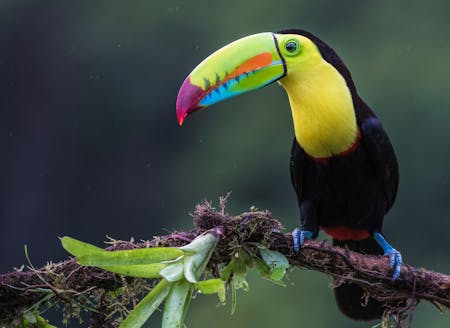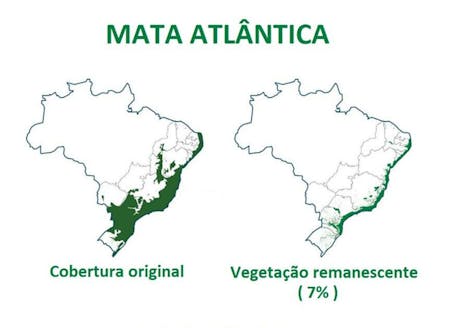Mata Atlântica nowadays
The atlantic forest
Located along the east coast of South America, the Atlantic Forest, the Mata Atlântica, extends inland to the Amazon and is one of the richest regions in the world for terms of biological diversity.

It hosts particular species that do not exist anywhere else in the world and forms a unique ecosystem characterized by exceptional fauna.
Beyond the spectacular mammals of the region (jaguar, puma, ocelot), there are several species of deer, two species of peccaries, the coati and several varieties of monkeys.
The forest is also home to more than 400 species of birds and 1,500 endemic plants, i.e. living nowhere else in the world. In total, it is estimated that 6,000 species, including 263 amphibians and 160 mammals, are endemic to Mata atlântica.

A lost forest
Mata Atlântica is one of the most threatened tropical forests in the world. The original extent of Mata Atlântica was approximately 1,300,000 km², or 15% of present-day Brazilian territory, and covered the entire coastal area, characterized by significant mountains, as well as the highlands of the hinterland. .
Today, having lost more than 90% of its original area and being totally fragmented, it is among the most threatened tropical forests on the planet.
* source : fishipedia
Numerous causes
Deforestation, accelerated since the beginning of the 20th century, has been caused mainly by urbanization, the coastline concentrating nearly 70% of the 210 million Brazilians with large metropolises such as São Paulo, Rio de Janeiro, Recife, Salvador de Bahia or even Porto Alegre.
Agriculture has also contributed to this deforestation, although the impact of these activities has been even greater in the interior of the country and on the fringes of the Amazon due to the monoculture of soybeans and animal husbandry.
Finally, the mining industry and the timber industry also have their share of responsibility.
There is still time to save the Mata Atlântica!
In recent years, awareness has arisen and many private and public actors have joined their efforts to safeguard the still intact areas of the Mata Atlântica and reforest entire territories.
At our level, at TIJUCA we participate in this reconquest by choosing producers invested in the protection of the forest and by financially helping those who fight for its preservation.